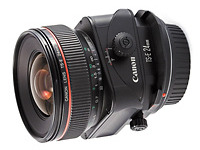There are 2197 lenses in our database and 3537 owners opinions.
You can also
compare lenses side-by-side
Search by:
Canon TS-E 24 mm f/3.5L
Specifications:
| Manufacturer | Canon |
|---|---|
| Model | TS-E 24 mm f/3.5L |
| Lens style | Wide angle |
| Focal length | 24 mm |
| Maximum aperture | f/3.5 |
| Angle of view | 84 o |
| Closest focusing distance | 0.3 m |
| Maximum magnification | 1:7.7 |
| Minimum aperture | 22 |
| Number of diaphragm blades | 8 |
| Auto focus type | MF |
| Lens Construction | 11 elements / 9 groups |
| Filter diameter | 72 mm |
| Macro | No |
| Available mounts | Canon EF |
| Dimensions | 86.7 x 78 mm |
| Weight | 570 g |
| Additional information |
Owners reviews (4)








Overall
Owner since: 1 month
Price: €700
User profile: Semipro
Cons: Chromatic aberrations. Tilt and shift functions cannot be rotated independently of each other. Some barrel distortion, but far less than the much newer and more expensive Nikkor 24mm pc-e). So far I haven\'t needed to correct it.
Pros: Decently (but not remarkably) sharp, even when shifted, assuming you stop down the lens, just how it is intended to be used. Chromatic aberrations are very easy to correct in ACR/LR. You can pick it up cheap (for a tilt shift) nowadays. Exceptionally good build quality, even for an L-Series lens The tilt/shift knobs are nice to use, (although seem to have a bit of rotational play, I presume that this is unique to my specific copy, which is over 30 years old). The locking knobs are useable, even with wollen gloves, unlike the Nikkor equivalent, which has tiny knobs that are borderline unusable at the best of times, and get stuck regularly.
Summary: The lens holds up to modern full frame sensors, if you are willing to do some careful post-processing on your images. ACR/LR handle the chromatic aberration removel very well, so long as you don\'t use the \"super resolution\" enhance option. The regular enhance, and the new AI noise reduction are okay. Not too sure why super resolution interferes with the C.A. corrections but it is what it is. This is definitely a tripod lens, treat it as such. It works okay for architecture and landscapes. As long as you don\'t mind some astigmatism in the far shifted corners, it is also not bad for anything astro/night based. Although the tilt and shift functions won\'t rotate independently of each other, you can easily modify the lens to do so yourself, although this is at your own risk. You can also send the lens off to canon if you don\'t want to do this yourself. If you can afford it, go get the Mark II, from what I\'ve read it is superior in quite a few ways, if you can\'t, just get this one, it really isn\'t as bad as some make it out to be. The photos this lens takes now aren\'t any worse than the photos it took in 2008 before the Mark II was released. An overlooked, hidden gem *if* you play to it\'s strengths!
Overall
Owner since: more than 10 years
Price: $900
User profile: Semipro
Cons: Image quality is unremarkable. Infinity needs a soft stop (focus past) to accommodate focusing while tilted. HORRIBLE chromatic aberrations: digital users will suffer mightily.
Pros: It's a tilt shift! Better IQ than the unremarkable EF 24mm 2.8 but that's hardly high praise.
Summary: Why Canon dedicated this mediocre lens an L is beyond me. Go out and get the twice-as-expensive-yet-worth-it Mark II version, which is more flexible and a high performer. Buy this one if you get it for $300.
Overall
Owner since: 1 month
Price: Rp 16.700.
User profile: Semipro
Cons: Little bit pincushion on hard shift
Pros: Almost all
Summary: Great, love the lens, creativity explorer
Overall
Owner since: 6 years
Price: 900 eur
User profile: Semipro
Cons: manual, opt.q.
Pros: build
Summary: not recomended